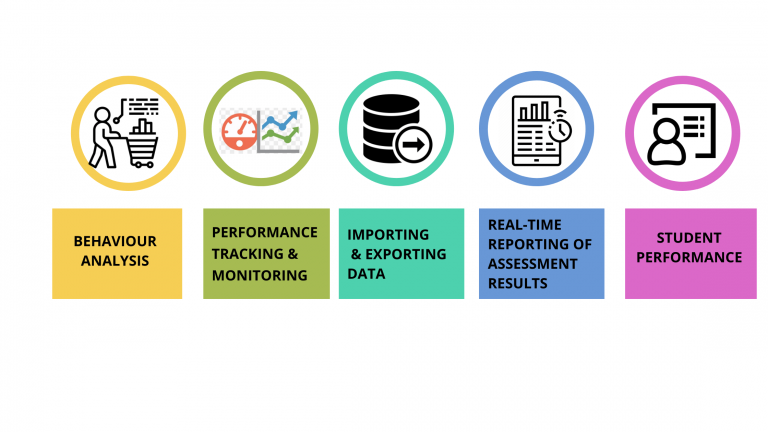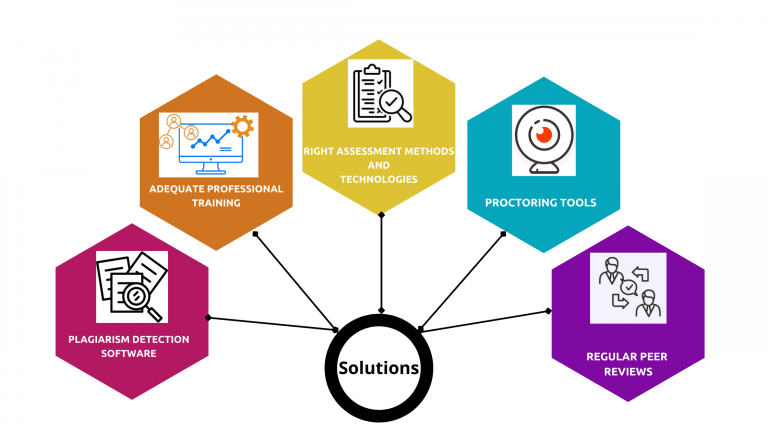Online Assesment in Schools-Challenges and Solutions
Assessment of student activities is an integral part of school education. Tracking the students’ progress helps in measuring the quality of education and identifying students’ strengths/weaknesses and improving the learning process. Assessment can also serve the purpose of offering certificates and grades that measure the degree of learning.
The Covid 19 pandemic and its related disruptions have badly affected the classroom learning process for students in India. Educational institutions have undertaken a sudden shift to online education to prevent the spread of the pandemic. The unpredictable changes happening in the educational sector have led to many challenges, particularly in conducting online assessments.
When school education underwent a sudden digital transformation, the assessment methods also became online. Even though there are certain challenges, online assessments provide numerous advantages over traditional classroom evaluations. The school community can easily tackle the difficulties and implement effective online assessment strategies with a bit of effort.
Let’s now explore the benefits, challenges and solutions to overcome the difficulties in conducting online assessments.
Importance of online assessments

In online assessments, educators use a wide variety of flexible & dynamic tools to evaluate, measure, and document students’ learning progress. With the help of such tools, the educators can get an overall impression of the student’s performance.
Here are some key benefits to consider:
Assessment reports and feedback: Online assessments bring quick and instant updates on student results in reports, notifications and other similar options. This helps the teachers on how the students are doing and the areas for improvement. For example, the results can be obtained in less time in an online test. So the teacher will be able to instantly identify which questions all students got wrong and which question concepts to be taught again to the entire class.
Easy test preparation & automatic evaluation: Teachers usually spend about 1-hour preparing and setting question papers in traditional school assessments. They also have the additional burden of carrying the question papers to different classes, distributing them to the students and correcting the answer sheet of each student (which alone can take up to 3 hrs for an average of 30 students). The boon of online assessment tools is that they offer automatic assessment for various modes of evaluation such as multiple-choice questions, fill in the blanks, true or false and even for some short descriptive answers. The assessment solutions also help in the easy preparation of all categories of questions. Thus, with the help of such tools, teachers can reduce their time and effort by 80%.
Automated test tools: Online assessment tools better collate crowdsourced question bundles. Working online makes it easier to prepare questions by selecting appropriate questions from such reusable and vast collections. It is easier for a teacher to mark and issue results. Some assessment systems also provide options to create automatic and randomized papers. These facilities offer huge flexibility for the teachers in preparing questions and save their time for the same. The storage efficiency in computer-based assessment is a great benefit that helps create large repositories of questions & answers, which makes it easy for students to revise, practice and learn.
Personalization of assessments: The evolution of technology made it possible to conduct personalized assessments based on each student’s learning ability and current proficiencies. Teachers can prioritize and develop different questions such as
multiple-choice, drop-down, free text, checkboxes, descriptive, and even image/audio/video answer questions. With such tools, the tutors can also analyze whether their students are visual, verbal or auditory learners. Various online assessment tools offer additional options for conducting formative and summative assessments. Pre-assessments (before teaching a new subject or course), quick short assessment at the end of a lecture, and automatic collation of data enable the teacher to measure the effectiveness of a class.
Reporting and analytics: Online school assessment tools provide detailed reports & analytics on students’ learning styles and proficiencies. While conducting exams, teachers can easily analyze the types of questions where students go wrong. Apart from normal evaluation methods like exams and quizzes, the online assessment system offers extra features such as behavior analysis, performance tracking & monitoring, importing & exporting data, and real-time reporting of assessment results & student performance. Such advanced tools help in analyzing student behaviors, their learning patterns and their interactions with course content & learning activities. With the reporting and analytics feature, online instructors can be responsive and adjust their teaching style accordingly.
Reduce paperwork & effort: Teachers and exam candidates can work on a device rather than using pen and paper. This saves the time, cost and organizational burden of running examinations based on printed question papers. Online tools also offer the benefit of organizing
interactive assessments that work on any device like desktops, tablets or smartphones that have internet access. Teachers can create an assessment and share its link with the students. The students can attend them from class or even from their homes through their devices. This facility also provides the examination body to offer candidates over greater geographical areas to offer exams.
Challenges of moving the assessments online

In recent years, as online learning has been adopted in numerous schools, factors such as the impact of physical distance between the students & instructors, workload, time management and the necessity of using technology for communication has posed challenges in how to adapt assessment practices for online and blended learning contexts. For educational institutions, It has become mandatory to implement relevant technology measures and other practices to overcome the difficulties of the online assessment techniques.
Here is a list of the major assessment-related challenges that arise in an online learning environment:
Validity and trustworthiness
Online assessments shall be reliable, transparent and feasible. Other key components include integrity, cheat prevention, privacy and accessibility. Assessment techniques such as project reports and assignments pose a serious threat of plagiarism. It can happen more often when the same resources are available for the students to refer to and when there are fewer interactions with the instructors. In the case of oral examinations & evaluations through video conferences, the absence of a strong and reliable internet connection can cause quality issues in assessment.
Measuring the learning outcomes
Not all learning outcomes can be measured using online assessments. Learning outcomes that can be evaluated through written assignments may work well; however, those are not enough for quality assessment. For instance, it is difficult to evaluate group dynamics during a group presentation when the group members are in separate locations. Authentic assessments like group projects, presentations, demonstrations, hands-on tasks etc. can be more challenging in an online context.
Rules and Regulations
Online evaluations and examinations are set in a digitized environment. However, certain rules and regulations are still applicable for those evaluations. Assessments operating in a virtual environment might require a shift in strategies, approaches and tools.
Unfamiliarity with education technology
For the educators and other school community members, a lack of knowledge in using technology for student evaluation can pose a threat to the quality of assessment. It can also result in poor time management. In the case of students who are not familiar with online tools, remotely proctored examinations and other online assessment methods can be stressful.
Lack of technology and gadgets
A reliable Internet connection and technical infrastructure are essential for deploying online assessments. All students might not have the adequate resources required for meaningful assessment activities. Evaluation through an online medium can be difficult if students or the institution lack the technical infrastructure required.
Interaction between students and faculties
Online learning methods restrict the direct student-to-student and student-to-instructor interactions. When students and instructors are in the same place at the same time, the exchange of verbal instructions is natural and easy. Virtual tutoring environments might require planned structures to support instant communication and feedback.
Solutions to overcome the challenges of online assessment:
» Educational institutes are required to have plagiarism detection software in place to avoid cheating. Having the assignments run through such a system can easily detect cut and paste content.
» All educators of the institute shall be provided with adequate professional training in utilizing modern assessment tools. Teachers and school authorities must ensure that students have the essential software and hardware resources to cope with this technology.
» Allow multiple opportunities for students to engage in self-assessment activities, collaborative problem-solving tasks and teacher-student conversations so that educators can get relevant and appropriate insights into their learning process. Systematically designing and delivering instructional materials can help teachers choose the right assessment methods and technologies to enhance learning.
» Proctoring is a great solution for preventing cheating and increasing the trustworthiness of various assessments. Schools can utilize proctoring tools that help to monitor the students while they take tests. Other strategies for cheat prevention include timed open-book tests, shuffled question papers, low stake tests with self-check activities and individual performance assessments.
» Conduct regular peer reviews where students are asked to review their peer’s work. Such activities can motivate the students to learn from each other. Additionally, activities like well-prepared group projects and debates can help students master the course material and improve their collaboration skills.
» Utilize strategies for receiving detailed feedback from the students for the online evaluation activities. Such strategies can include online polls, weekly surveys, actively managing discussion boards etc. Break up large projects into smaller ones so that students don’t feel overwhelmed. Build tools to monitor a large number of students and also design rubrics to be used as self-assessment or peer-review.
» For accomplishing performance assessments, the institutions shall advise the students to utilize properly working and reliable hardware and software components so that the quality of an assessment can be improved. To make the sessions more interactive, incorporate relevant multimedia such as drag and drop activities, audiovisual assessments, image-based activities etc.
» Use multiple assessment techniques like MCQs, student e-portfolio assessment, descriptive assessments, online role plays, scenario-based activities, online discussions etc. They will help to measure the outcomes of different learning styles.
Education is constantly evolving; the pandemic has intensified the need to adopt new technology-based resources and methods that better support student learning and assessment. Schools are forced to change and expand assessment strategies into online and blended learning concepts. While implementation strategies can differ in various online environments, assessments need to align with course objectives and consistently measure student activities.
The school community is required to prioritize open communication among all stakeholders involved. They must continue to allocate time, resources, and support for conducting online assessments and promoting a positive assessment culture. Implementing relevant technologies in online assessments to measure the learning outcomes can make the students more competence-based and prepare them to meet the demands of the future job market.

